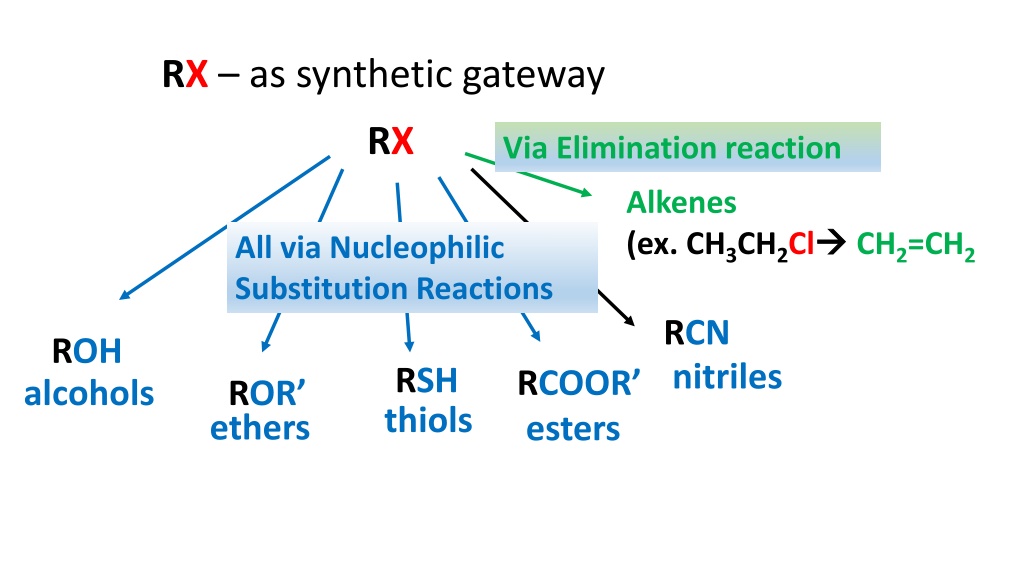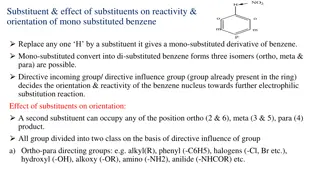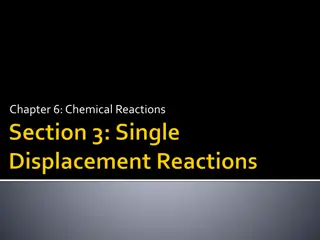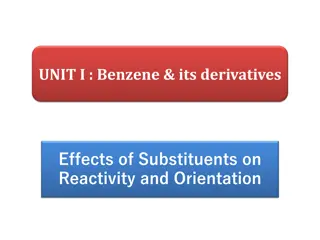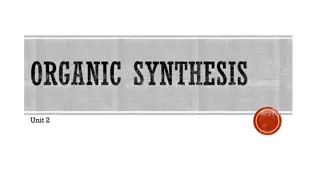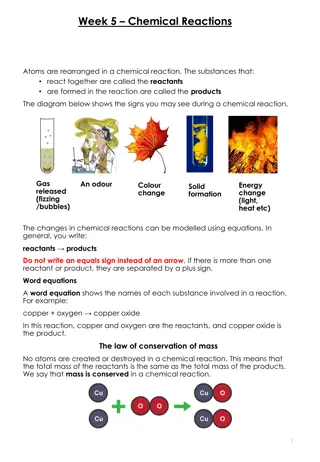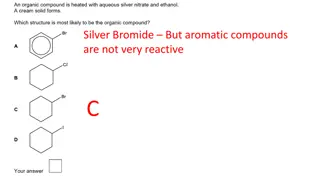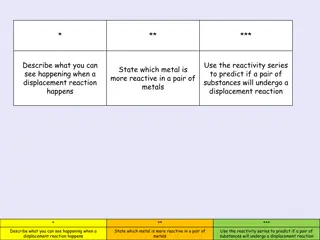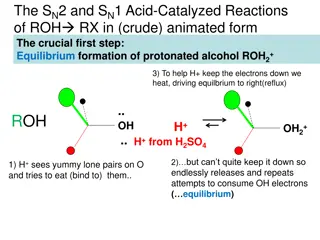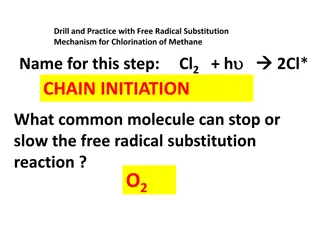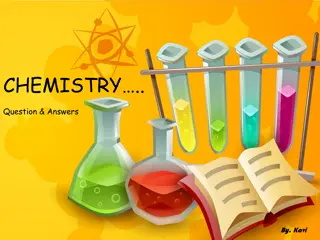Nucleophilic Substitution Reactions: Factors Affecting SN2 Reactivity
Understanding the factors influencing SN2 reactions in synthetic gateways involving elimination reactions of alkenes is crucial for predicting reaction rates. This includes analyzing the impact of solvent types on reaction rates in different scenarios. Polar protic solvents and polar aprotic solvents each have distinct effects on SN2 reactions, affecting the reactivity of different substrates based on steric effects and solvent properties.
Download Presentation

Please find below an Image/Link to download the presentation.
The content on the website is provided AS IS for your information and personal use only. It may not be sold, licensed, or shared on other websites without obtaining consent from the author. Download presentation by click this link. If you encounter any issues during the download, it is possible that the publisher has removed the file from their server.
E N D
Presentation Transcript
RX as synthetic gateway RX Via Elimination reaction Alkenes (ex. CH3CH2Cl CH2=CH2 All via Nucleophilic Substitution Reactions RCN nitriles ROH alcohols RSH thiols RCOOR esters ROR ethers
Cat analogy for SN1 vs SN2 SN1 SN2
Factors influencing the rate of an SN2 reaction of RX 1) What s on the site along with X- an example: RBr RI SN2 Reaction rate favors lower degree : a `steric effect CH3 H H CH3 H3 C C Br 2o H H3 C C Br 1o H H C Br 0o H H3 C C Br 3o CH3 site degree Relative Rate 145 1 0.008 0.0000
Factors influencing the rate of an SN2 reaction of RX (cont.) 2) What s on the site along with an example: 1oRBr RI SN2 Reaction rate favors lower degree : a `steric effect (again) H H H Br Br CH3 Br Br C H3 C C H C H C H3 C CH3 CH3 CH3 H Site degree 1o 4o 2o 3o 0.04 0.00001 0.8 Relative rate 1
Take-home message so far: SN2 is favored mostly by 0o and 1o sites and 1o and 2 sites. Higher degree , won t run SN2
Factors influencing the rate of an SN2 reaction of RX (cont.) 3) What s the effect of solvent on SN2 rates ? Br + N3- SOLVENT ? N3+ Br- Dipole moment, Dielectric constant, Solvent Relative Rate Type CH3OH 2.87 33 1 protic H2O 1.84 78 7 protic DMSO 3.96 49 1,300 aprotic SN2 prefers `softer , polar aprotic solvents DMF 3.82 37 2,800 aprotic CH3CN 3.92 38 5,000 aprotic
POLAR PROTIC SOLVENTS (polar and with ability to be H- bond donor) have dipoles due to polar bonds have O and H atoms that can be donated into a H-bond examples are the more common solvents like H2O and ROH Anions (Nu-) will be solvated due to H-bonding, inhibiting their ability to function as Nu
POLAR APROTIC SOLVENTS (polar but no ability to be H-bond donor) have dipoles due to polar bonds don't have O or H atoms that can be donated into a H-bond examples are acetone, acetonitrile, DMSO, DMF (structures below) anions (Nu-) are not solvated and are "naked" and reaction is not inhibited by solvation of Nu- DMSO DMF Acetone Acetonitrile
Factors influencing the rate of an SN2 reaction of RX (cont.) 3) What s the effect of solvent on SN2 rates (cont.) CH3-I + Nuc- CH3-Nuc +I- Nuc- rate in CH3OH I 43 Br 1 Cl 0.04 F 0.0006 49,000 x 82,000,000 rate in DMF relative increase 6,500 21,000 41,000 x 150 x 21,000 x 1,030,000
Factors influencing the rate of an SN2 reaction of RX (cont.) 4) What s the effect of leaving group on SN2 rates ? The best leaving groups form the most stable Conjugate bases and come from the strongest Acids (pKa < 0 )
Factors influencing the rate of an SN2 reaction of RX (cont.) 4) What s the best Nuc- for increasing SN2 rates ( strength of Nucleophilicity)?Nuc- Factors favoring faster SN2 a) Stronger bases (with negative charges) are often stronger nucleophiles (but not always): CH3CH2O- is way stronger than CH3CH2OH b) Nuc- strength is lowered by electron-withdrawing groups: CCl3- is weaker than CH3-
Factors influencing the rate of an SN2 reaction of RX (cont.) 4) What s the best Nuc- for increasing SN2 rates (cont.) ? Nuc- Factors favoring faster SN2 (cont.) c) Higher polarizability yields higher Nuc- strength in polar protic solvents. Going down the Periodic Table means increasing Nuc- strength. In polar protic solvents SH- is stronger than OH- In polar protic solvents I- > Br- > Cl- >F- (see table 7.3 of text)
Factors influencing the rate of an SN2 reaction of RX (cont.) 4) What s the best Nuc- for increasing SN2 rates (cont.) ? Nuc- Factors favoring faster SN2 (cont.) d) Higher polarizability yields lower Nuc- strength in polar aprotic solvents. That is, changing the solvent from polar protic to polar aprotic switches the order In polar aprotic solvents OH- is stronger than SH- In polar aprotic solvents F- > Cl- > Br- >I- (see table 7.3 of text)
Factors influencing the rate of an SN2 reaction of RX (cont.) 4) What s the best Nuc- for increasing SN2 rates (cont.) ? Nuc- Factors favoring faster SN2 (cont.) e) Nuc- strength is lowered by spreading the negative charge around via resonance. O- H O Is stronger than CH CH3 O-
Factors influencing the rate of an SN2 reaction of RX (cont.) 4) What s the best Nuc- for increasing SN2 rates (cont.) ? f) Smaller is better for Nuc- . Steric hindrance always slows down SN2 O- > > O- O- O-
Nucleophilicity and Basicity are not the samebut intertwined strong nucleophile weak nucleophile N Strong base NaH OH- CH3O- C2H5O- N H2O CH3OH C2H5OH I- Br- Cl- HS- RSH H2S weak base
Examples of Nucleophile strength order: tell me why Why Must be in polar protic -polarizability increases down column I- > Br- > Cl- >>F- CH3CH2- > CH2Cl-CH2- Neighboring electronegative group reduces basicity Must be in polar aprotic where strength decreases down column CH3S- < CH3O- NH2- > NH3 O- Negative charge beats no charge O- > No resonance beats resonance (don t spread out charge)
O- Steric effect smaller is always better for nucleophiles < O- Cat rule, dogs drool (and poop on the carpet) >
